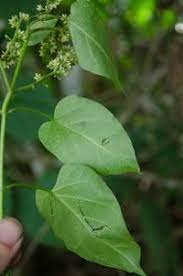NAME: Hedranthera barteri
COMMON NAMES: Hedranthera
LOCAL NAMES: Agbo omode
MORPHOLOGICAL DESCRIPTION: Hedranthera barteri is a perennial plant known for its distinctive appearance. It typically features the following characteristics:
Leaves: The leaves of Hedranthera barteri are simple, opposite, and ovate to elliptical in shape. They are often dark green and can have a glossy appearance.
Flowers: The plant produces small, fragrant, tubular flowers with various colors, such as white, pink, or purple.
Growth Form: This plant can take on a shrub-like form with a branching structure.
USEFUL PART(s): The plant is primarily valued for its leaves and, in some cases, its flowers.
GENERAL USES:
Ornamental: Hedranthera barteri is often grown as an ornamental plant in gardens and landscapes due to its attractive foliage and colorful flowers.
Traditional Uses: In some regions, extracts or preparations from the leaves may be used for traditional or herbal remedies, but it's essential to exercise caution and seek professional guidance when considering such uses.
GEOGRAPHIC DISTRIBUTION: Hedranthera barteri is native to West Africa, particularly in countries like Nigeria and Cameroon. It may also be cultivated as an ornamental plant in various other regions.
WHY IS IT GREEN? The green color of Hedranthera barteri's leaves is due to the presence of chlorophyll, the pigment responsible for photosynthesis. Chlorophyll absorbs light in the blue and red parts of the electromagnetic spectrum and reflects green light, giving the leaves their characteristic color.
ENVIRONMENTAL IMPACT: Hedranthera barteri may contribute to local biodiversity by providing habitat and food for various insects and small wildlife. When grown as an ornamental plant, it can add to the aesthetic value of gardens and landscapes, but its environmental impact largely depends on its cultivation and management.
FUN FACT: Hedranthera barteri is appreciated for its ornamental value in horticulture due to its vibrant and colorful flowers. It can be an attractive addition to gardens and is known for its unique foliage.
Further Reading: To explore further information about Hedranthera barteri, you can consult botanical references, gardening and horticulture guides, and regional plant resources. Additionally, if you're interested in its traditional uses, consider exploring ethnobotanical studies specific to the regions where it is found.





















